Final Report for GNE15-095
Project Information
Living mulch systems are an excellent strategy for increasing diversity and resource use efficiency in agro-ecosystems, increasing soil organic matter, and for preventing or reducing soil erosion through quick soil cover. Presence of living mulches is also an excellent deterrent to inter-row tillage during the season. However, adoption of living mulches is constrained by problems of excessive competition with the cash crop and unreliable weed control. It was expected that combinations of living mulches with herbicides would complement each other, thereby reducing both living mulch vigor and herbicide input without compromising weed control or crop yield. In both 2015 and 2016, two separate field trials were carried out. In one trial (tomato trial), sunnhemp was used as living mulch in a fresh market tomato crop. In the other trial (sole cover crop trial), sunnhemp was used along with herbicide combinations in the absence of a crop. Approximately 2.5 tons ha‑1 of dry matter was produced in the tomato trial by the living mulch in both years. During late August, the living mulch-herbicide treatments provided soil cover of 87% in 2015 and 94% in 2016. Compared to the untreated check, which had no herbicide applications, the herbicide treatments reduced tomato yield losses by 71% in 2015 and 51% in 2016. In 2016, weed biomass in the living mulch treatments was only between 0.3 to 2.1 tons ha‑1, a reduction of up to 97% relative to the weedy check (9 tons ha‑1). Herbicide applications rates were successfully reduced by up to 75% in metribuzin and 81% in rimsulfuron, without compromising weed control, living mulch biomass, soil cover or crop yield. In the sole cover crop trial, the herbicide applications were able to reduce cover crop height by 9 to 41 cm.
Introduction:
There is an increasing emphasis on improving the sustainability functions of agro-ecosystems. Even though cover crops are used in many different cropping systems, research has been mostly in the area of winter cover crops. However, it is important to develop methods for management of living mulches. Development of these strategies to make living mulch systems feasible is critical to their adoption. Living mulch systems can be used successfully in most production systems. But, they are most suitable for small-scale, diversified farms. Adoption of living mulches is an excellent strategy to increase diversity and resource-use efficiency and to improve the population of beneficial fauna and microbes. Vegetable crops take a relatively long time to cover the soil surface effectively. Living mulches can help to provide quick and effective soil cover early in the season, before the onset of the rains. This is beneficial in minimizing soil displacement and erosion. Another indirect benefit of living mulch systems is that, by making inter-row cultivation difficult, presence of living mulches are an excellent deterrent to inter-row tillage during the season.
As listed in the Project Proposal, the following are the expected benefits from inter-seeded cover crop/living mulches:
- Quick soil cover between vegetable rows
- Use of tropical living mulch species that can effectively use the summer climate
- Elimination of inter-row tillage and overall reduction in cultivation, which can minimize soil erosion, soil compaction and destruction of soil structure
- Reduction in nitrogen fertilizer input in the long term, from use of legume living mulch species and also from more efficient use of nitrogen fertilizer input
- Decrease in soil erosion, runoff and leaching of fertilizers and pesticides; and increase in infiltration
- Improvement in resource utilization, healthier presence of beneficial fauna and microbes and better microclimate
- Reduction in herbicide input through reduction in application rates, by taking advantage of weed suppressive abilities of vigorous living mulches
However, there are two major challenges to adoption of living mulch systems: excessive competition with the cash crop, and unreliable weed control. The main goal of these experiments is to research the potential of using herbicide applications at reduced rates to mitigate these problems. It is expected that the living mulch and herbicides will be able to complement each other in such a way that the herbicides can assist the living mulch in weed suppression, while the living mulches make the reduction in herbicide rates feasible through its own contribution to weed control. This reduction in herbicide application rates will translate to reduction in herbicide input. The herbicide applications, while helping to suppress weeds, will simultaneously suppress living mulch vigor also. And this, in turn, will help to minimize the competition between the living mulch and the cash crop. Since living mulch systems are complex, considerable emphasis needs to be placed on vegetable yield when designing strategies for living mulch planting and management. Weed control is also of critical importance in vegetables. So, it is important, in such a system, that the herbicide type and application rate are carefully considered in the context of the crop, living mulch and weeds, and their growth stages. These factors would, upon herbicide application, determine the ecological interactions between the crop, living mulch and weeds.
Living mulches have the capacity to perform a lot of sustainability functions in an agro-ecosystem, and it is assumed that these contributions outweigh its role in weed control. As such, herbicides are evaluated as a tool to enhance agro-ecosystem sustainability. Another significant contribution of living mulches can be elimination of the use of pre-emergent herbicides. Due to the need for living mulch establishment, pre-emergent herbicide use may be constrained. Pre-emergent herbicides tend to be used at higher rates than post-emergent herbicides, and are also more persistent in the soil (Teasdale 1996). Herbicide contamination of ground and surface waters from leaching and run-off is also primarily from pre-emergent herbicides (National Resource Council 1989). On its own, this study will not provide growers with ready to use information for all circumstances. In order to achieve that, several living mulch species, herbicides and herbicide application rates must be evaluated in various crops. This study into this largely unexplored area, if successful, can encourage further examination, thus opening new avenues in cover crop research.
References
Committee on the role of alternative farming methods in modern production agriculture (1989). National Research Council. Alternative Agriculture
Teasdale JR (1996) Contribution of cover crops to weed management in sustainable agricultural systems. Journal of Production Agriculture 9(4):475-479
The broad goal of these field trials was to evaluate the potential of living mulch-herbicide combinations as a technique to advance the feasibility of living mulch systems. The major criteria for this examination were management of living mulch vigor, effective weed suppression, reduction in herbicide input, and prevention of crop yield losses. It was expected that the chosen living mulch species, herbicides, herbicide applications rates and the planting and management techniques used in the management of the system, will have no adverse effect on the vegetable crop, while providing effective weed suppression and soil cover, and generating considerable amounts of living mulch biomass. The specific objectives of the experiments were:
- To study the effects of the various herbicides and (reduced) rates of application on sole cover crop stands, measured in terms of cover crop recovery times and reductions in biomass, plant height, ground cover and stand density, and to study the effect of the cover crop-herbicide combinations on weed pressure, measured in terms of reduction in biomass, density and ground cover. Ten different herbicide treatments were evaluated on discrete cover crop stands, along with an untreated cover crop check and a weedy check. All aforementioned cover crop and weed parameters were measured, several of them multiple times during the growing season.
- To study the effects of treatments (chiefly, cover crop-cash crop competition and weed pressure) on the vegetable crop, measured in terms of vegetable yield and tissue analyses of nutrient composition. Using the living mulch, weed and crop parameters measured from the tomato trial, the effects of four different herbicide treatments were compared along with a weed-free hand-weeded control, an untreated living mulch check and a weedy check. Tomato leaf tissue was analyzed for nutrient composition in 2015 and in 2016. In 2016, nutrient composition of sunnhemp tissue was also carried out, along with analyses of the soil.
- To study the effects of herbicide treatments on the living mulch performance, measured in terms of reductions in biomass production, plant height, ground cover and stands density. Even though living mulch performance is correlated to the cropping system’s contributions to sustainability, control of living mulch vigor is an important function of the herbicide applications. This suppression is crucial to prevent excessive competition between the living mulch and the vegetable crop.
- To study the effects of herbicide treatments on weeds, measured in terms of weed biomass and ground cover. Adequate weed control, especially in vegetable systems, is critical for adoption of any cropping system. Living mulch systems make weed management more complicated, but they also provide a unique opportunity for reducing herbicide application rates. Weed parameters were measured and analyzed to find out if the reductions in herbicide input were indeed practicable in living mulch systems.
- To study cover crop performance, measured in terms of biomass production, extent and duration of ground cover, stand density, plant height and nutrient composition of tissue. The living mulch is the main contributor to the sustainability functions of a living mulch system, and as such living mulch parameters, especially ground cover and biomass are important. Good soil cover and biomass production are expected from the living mulches.
Cooperators
Research
Field trials were carried out in 2014, 2015 and 2016 at the Homer C. Thompson Vegetable Research Farm, Freeville, NY. In 2014, a preliminary field trial was conducted using sesbania (Sesbania sesban (L.) Merr.) and sunnhemp (Crotalaria juncea L.) as living mulch species in a fresh market tomato crop. During each subsequent year, two separate field trials were conducted. One trial was similar to the trial carried out in 2014; this trial is hereafter referred to as the tomato trial. The other trial, hereafter referred to as the sole cover crop trial, consisted of only the cover crops without a cash crop. The purpose of the sole cover crop trial was to evaluate herbicides not registered for use in tomato, and also to test more herbicide combinations. Due to the absence of a cash crop in the sole cover crop trial, the cover crops are not referred to as living mulches. But, the plants are of the same variety and species, and from the same batch of seeds.
During the preliminary trial in 2014, each herbicide treatment consisted of two applications of one herbicide, at a fixed application rate. The herbicides used were halosulfuron, metribuzin and rimsulfuron. In 2015 and 2016, fomesafen was included as a herbicide in the tomato trial, while in the sole cover crop trial, fomesafen, imazethapyr and s-metolachlor were included. Herbicide treatments were also modified to include two kinds of herbicides. The herbicides were categorized into two types based on the extent of cover crop/living mulch injury. Type 1 (fomesafen, rimsulfuron, s-metolachlor) herbicides caused more severe injury than Type 2 (halosulfuron, imazethapyr, metribuzin) herbicides. Each herbicide treatment consisted of a combination of one application each of two herbicides. Such a combination of two herbicides, instead of two applications of the same herbicide at a fixed rate, was expected to be more effective in weed control. These changes from 2014 were revisions made to the herbicide treatments provided in the Proposal.
Pre-emergent herbicide applications were not used in any of the trials to prevent hindrance to living mulch/cover crop establishment. All herbicide applications in the treatments were applied post-emergent. Even herbicides, which are typically used as pre-emergent herbicides, were applied post-emergent. All herbicide applications included in the treatment were applied along with a non-ionic surfactant. Grass herbicides were not included as part of the treatments, but they were applied over the entire field when required, which was approximately twice a season. Herbicide treatment applications were made using a pressurized (35 psi) carbon dioxide backpack sprayer. The field trials were set up in a split-plot design with strips of the cover crops as the main plots and the sub-plots of herbicide treatments randomized within these main plots. Treatments were replicated four times in the tomato trial, and three times in the sole cover crop trial. In 2014, emergence and subsequent establishment of sesbania was poor. This was the case in 2015 also. Most likely, emergence and seedling establishment of the small seeded sesbania was affected by the cold conditions during 2014 summer, and the wet conditions in 2015 summer. As such, since data collected from sesbania treatment plots was not credible, sesbania was not used in 2016.
Tomato trial
Tomato was seeded in the greenhouse towards the end of April. In all years, a fresh market variety of tomato, Mountain Fresh F1, was used. Sesbania and sunnhemp were planted in late May using a grain seed drill. The fields were fertilized using the recommended rates for tomato; and no additional fertilization was carried out to compensate for the living mulch. The living mulches were planted at a seed rate of 40 kg ha‑1 for sesbania and 45 kg ha‑1 for sunnhemp, with a row spacing of 23 cm. Once the living mulches had emerged and were about 5 cm tall, in an alternating fashion, sets of three rows were taken out with hand hoes in order to accommodate the tomato crop. So, tomato rows were spaced 122 cm apart, with three rows between two rows of tomatoes, such that the living mulch rows were 40 cm away from the tomato row on either side. Approximately a month-old tomato transplants were hand-transplanted into the field at a plant-to-plant spacing of 46 cm. Irrigation was provided whenever required. Almost no irrigation was done in 2015 since it was a very wet year, while in 2016, frequent irrigation was provided through overhead sprinklers.
Individual treatment plots measured 3.7 by 4.6 m and consisted of four tomato rows. The tomato trial consisted of a total of seven treatments (Figure 1), comprising of four herbicide combinations, a weed-free hand-weeded control, an untreated living mulch check with no herbicide applications, and a weedy check with no living mulch, no herbicide applications, or any other weed management operation. The first set of herbicide applications were made approximately a month after living mulch emergence, when they were about 20 to 35 cm tall with 50 to 75% ground cover. Typically, the living mulches, especially sunnhemp, emerged much sooner than the weeds, and so, were much larger than the weeds at the time of the first herbicide application. Since there are not many herbicides registered for use in vegetable and specialty crops, this difference in size plays a critical role in the desired asymmetrical targeting of weeds by the herbicide applications. Approximately 15 to 20 days later, usually in mid to late-July, the second set of herbicide applications was made. Before the second set of herbicide applications, the living mulch must have recovered sufficiently from the first herbicide application. However, any delays must be carefully considered so that harvests may not be delayed due to the post harvest intervals for the herbicide applications. Herbicide applications were made using a two-nozzle boom and a span of 122 cm.
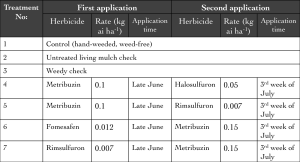
Ground cover provided by the living mulch, living mulch height and weed cover were measured several times during the course of the season. Ground cover was determined through visual estimations. For nutrient composition analyses, tomato tissue samplings were carried out during peak tomato flowering. In 2016, sunnhemp tissue was also sampled at this time for nutrient analyses. Living mulch density and biomass, and weed density and biomass were measured immediately before beginning of tomato harvest, approximately during early September. Sampling units for living mulch density and biomass were two randomly selected 50 cm stretches of living mulch row per plot. In both the tomato trial and the sole cover crop trial, and in case of both living mulches and weeds, biomass refers to only the aboveground biomass. As such, for biomass sampling, plants were cut at ground level. For determination of weed density and weed biomass, sampling units consisted of two randomly selected 50 by 50 cm area within the two central inter-row spaces. Fresh weight of biomass samples were measured, after which dry weight was also measured following oven drying at 80°C for two weeks. Hereafter, unless mentioned otherwise, biomass (of both living mulch and weeds) refers to dry matter weight. Tomato yield estimations from each plot were made from the cumulative yield from the two middle rows. Although Mountain Fresh F1 was expected to be a determinate variety, during all years, 3 to 4 harvests were carried out over, approximately, a three-week period.
Sole cover crop trial
Field preparation and fertilization for the sole cover crop trial was identical to the tomato trial. Sesbania and sunnhemp in the tomato trial and the sole cover crop trial were planted on the same day, and at the same seeding rate. The sole cover crop trial was not initiated in 2014. Emergence of both sesbania and sunnhemp were poor in 2015, likely due to extremely wet conditions at the time of planting. Since sunnhemp had performed better than sesbania, and because emergence and establishment of sunnhemp was acceptable in the tomato trial, sunnhemp was replanted adjacent to the initial planting area, at the same site. Only sunnhemp was planted in 2016.
Individual plots in the sole cover crop trial measured 1.8 by 3.1 m and consisted of nine rows, spaced 23 cm apart. In total, twelve treatments were tested (Figure 2), which included ten herbicide combinations, an untreated check, and a weedy check. Most management operations like irrigation in the two trials were conducted together. Herbicide applications in the sole cover crop trial were made based on the same cover crop factors as in the tomato trial, and were usually made temporally close to each other. Measurement of cover crop and weed parameters were also done at approximately the same time, and in the same fashion. Nutrient analyses of cover crop tissue were not done in the sole cover crop trial.
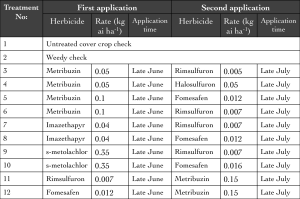
Preliminary inoculated living mulch trial
Neither of the two cover crop/living mulch species was inoculated during any of the three years, in any of the two trials. In 2016, it was decided to cursorily examine the effects of living mulch inoculated with nodule-forming rhizobia bacteria. So, adjacent to the tomato trial, two treatments (rimsulfuron + metribuzin and the untreated cover crop check) were replicated four times, in a set up identical to the tomato trial. Planting, management, treatment plots and application of treatments, data collection, etc. in this test were similar to the tomato trial, and were carried out at the same time. The only difference between the two was the inoculation of sunnhemp. When, for nutrient analyses, tomato and sunnhemp tissue were sampled in the tomato trial, tomato and sunnhemp plants were also sampled from the plots at the inoculated trial. However, after this sampling, which was conducted at peak tomato flowering, another set of tissue sampling, along with soil sampling, was conducted immediately before beginning of tomato harvest. This was done to find out if inoculation of the living mulch resulted in any remarkable changes in nutrient concentrations in tomato tissue, sunnhemp tissue, or soil.
It was expected that inoculation of the legume living mulch would minimize living mulch-vegetable competition for nitrogen. However, it was possible that the increased availability of nitrogen to the inoculated sunnhemp (relative to the non-inoculated sunnhemp) would make it less competitive with the weeds in the inter-row space. By tying up lower amounts of nitrogen from the inter-row space in its tissue, the inoculated living mulch was likely to make the inter-row space a less competitive area for nitrogen, compared to the non-inoculated sunnhemp, which would get all its nitrogen from the fertilizer input. In the non-inoculated sunnhemp, there was no noticeable nodulation, indicating that the specific rhizobia required for sunnhemp was probably absent in the soil.
Analysis of Variance (ANOVA) was used to test for treatment effects and regression analysis was used to explore relationships between various crop, living mulch and weed parameters, both at 5% level of significance. Tukey’s HSD test was used to compare treatment differences. Statistical analyses were carried out using the JMP Pro statistical software (JMP® Pro Version 12.0. SAS Institute Inc., Cary, NC). Since sesbania did not perform satisfactorily, the data and discussion presented here are focused on sunnhemp only. And, the design of both trials were considered to be a randomized complete block design, and not split plot. The summer of 2014 was relatively cold, the summer of 2015 was very wet and the summer of 2016 had a severe and extended drought. Due to these conditions during each year, data was not pooled across the years; instead, data from each year was analyzed separately.
Tomato trial
Tomato yield from the herbicide treatments were up to 10 tons ha‑1 higher than the weed-free hand-weeded control (66 tons ha‑) in 2014. In 2015 and 2016, the control plots (33 tons ha‑1 in 2015 and 101 tons ha‑1 in 2016) had the highest yields. While in 2015, tomato yield from the herbicide treatments (16 to 27 tons ha‑1) were statistically comparable to the control, tomato yield from all the herbicide treatments in 2016 (58 to 66 tons ha‑1) were lower than the control (Figure 3).
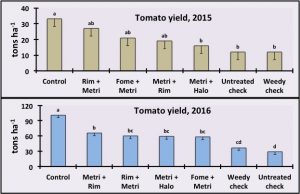
The incidence of disease was high in 2015 since it was a very wet year. Presence of living mulches in these conditions would have made the tomato plants more vulnerable to disease. However, in 2015, tomato yield increased with increasing living mulch biomass, which means that more the vigorous living mulch stands were beneficial to tomato yields (Figure 4). So, reductions in tomato yield were likely not caused by living mulches.
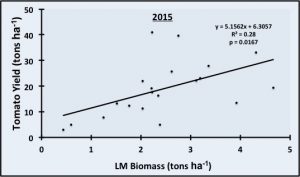
During this year, increasing order of treatments in terms of tomato yield was almost identical to the decreasing order of treatments in terms of weed biomass (Figure 5).
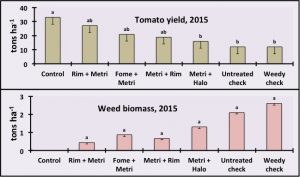
This is probably an indication that among the mixture of living mulches and weeds, the weeds alone were responsible for adversely affecting tomato yields. If the tomato crop had been affected by the competition from both living mulches and weeds, then there would have been a negative relationship between tomato yield and the combined biomass of living mulch and weeds. But, this was not the case. The combined biomass of living mulch and weeds had no (positive or negative) relationship at all with tomato yield. This provides further corroboration to the earlier inference that it was solely the weeds, and not the living mulch, that adversely affected tomato yields.
In 2015, the living mulch generated 2.1 to 2.8 tons ha‑1 of biomass in the herbicide treatments, while the untreated cover crop check with no herbicide applications recorded 2.7 tons ha‑1 of living mulch biomass (Figure 6).
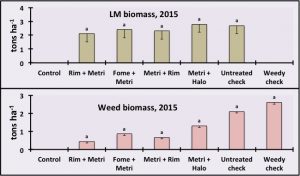
This indicates that the herbicide treatments did not really affect living mulch biomass production. On the other hand, weed biomass ranged from 0.43 to 1.33 tons ha‑1 in the herbicide treatments, whereas, weed biomass in the weedy check was 2.64 tons ha‑1. Hence, all herbicide treatments were able to considerably suppress weeds. The fact that the herbicide applications considerably reduced only weed biomass, and not living mulch biomass, is indicative that, as expected, the herbicide applications were capable of disproportionately targeting the weeds.
Surprisingly, there was no relationship between living mulch biomass and weed biomass (Figure 7).
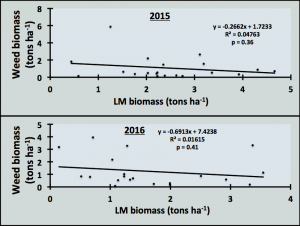
Increase in living mulch biomass/vigor was expected to decrease weed biomass. This however, suggests that herbicide applications played an important role in weed control. The range of weed biomass in the herbicide treatments was similar in 2015 and 2016. But, unlike in 2015, tomato yield decreased with increasing living mulch biomass and weed biomass in 2016 (Figure 8).
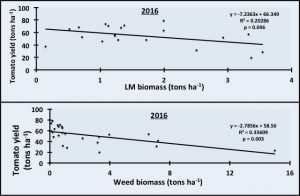
The summer of 2016 was very dry, and although irrigation was provided, the reduction in tomato yield was likely to be a consequence of competition for water. The positive relationship between tomato yield and living mulch biomass in 2015 could then, have been possible due to lack of living mulch-tomato competition for water under the wet conditions.
In 2014, living mulch biomass negatively impacted tomato yield (Figure 9). However, scarcity of water was not likely to be a cause for this since, even though the summer of 2014 was relatively cold, soil moisture conditions were adequate. The reason for this relationship is likely due to the unexpected positive relationship between weed cover and living mulch biomass during 2014 (Figure 10). Weed pressure was higher in plots with more vigorous living mulch stands. Furthermore, tomato yield decreased with increasing weed pressure (Figure 11). So, like in 2015, it is likely that only the weeds adversely affected the tomato crop, even though there was a negative relationship between tomato yield and living mulch biomass, which was created due to the positive association of living mulch biomass with weed pressure.
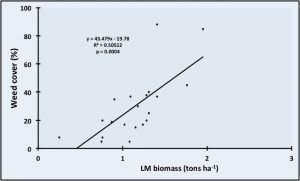
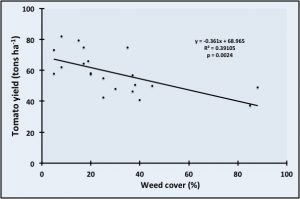
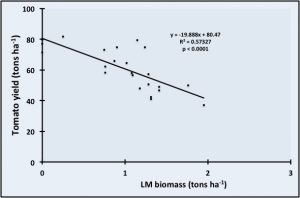
The reason for this anomalous positive relationship between living mulch biomass and weed pressure was probably because the living mulch was not able to adequately suppress the weeds by itself, without sufficient assistance from the herbicide applications. Herbicide treatments in 2014 did not consist of different herbicide types, but only two applications of one herbicide at a fixed rate. So, in plots where weaker herbicide applications were used, living mulch vigor was not affected much, and larger amounts of living mulch biomass was produced. However, at the same time, the weeds were also affected to a lesser degree, causing their presence to extend too, due to insufficient suppression from the living mulch. In those plots where stronger herbicide applications were used, both the living mulch and the weeds were affected more, leading also to greater reductions in living mulch biomass. But, in this case, tomato yield was improved. The herbicide treatment, after they were modified in 2015 in order to asymmetrically target weeds, were able to prevent any relationship between living mulch biomass and weed biomass in 2015. In 2016, perhaps due to the extremely dry conditions leading to excessive competition for water, the weed biomass decreased with increasing living mulch biomass.
In 2016, due to scarcity of water, it was likely that living mulches had another adverse impact on tomato yield. More vigorous living mulch stands (which produce greater amounts of biomass) remove more water from the soil, thereby making it comparatively drier. In tomato, dry soil conditions can lead to calcium deficiency in the plants because optimum uptake of this nutrient requires sufficient soil moisture. This can lead to yield losses from bottom rot disease. During this year, concentration of calcium in tomato leaf tissue was found to decrease with increasing living mulch biomass, which supports the hypothesis that more vigorous living mulch stands affected the tomato crop more through removal of higher quantities of water from the soil. These results substantiate the necessity for adequate soil moisture conditions in living mulch systems.
In 2016, tomato yield from the untreated cover crop check (29 tons ha‑1) was lower than even the weedy check (37 tons ha‑1). In comparison, tomato yield from the control was 101 tons ha‑1 and in the herbicide treatments, tomato yield ranged from 58 to 66 tons ha‑1. Since weed biomass from the untreated check (2.1 tons ha‑1) was much lower than from the weedy check (9 tons ha‑1), weed pressure was likely not responsible for this outcome. However, the untreated check was very different from the other treatments in terms of living mulch height (116 cm). Height of weeds was not measured, but they were shorter than the living mulch in the untreated check. Tomato yield decreased with increasing living mulch height. When tomato yield from the treatments were adjusted for living mulch height before running the analyses, the untreated living mulch check projected a 44% increase in yield. The herbicide treatment reduced living mulch height by 16 to 49 cm (14 to 42% reduction, respectively). Reduction in living mulch height was expected to be an important function of the herbicide applications, and these results support our hypothesis.
The negative impact of excessive living mulch height on tomato yield was observed in 2014 also, but not in 2015. In 2015, there was no relationship between tomato yield and height of the living mulch stand. This could perhaps, be because the only major competitive stress on the tomato crop from the living mulch was probably shading caused by excessive living mulch height. Whereas in 2014 and 2016, the negative relationship between tomato yield and living mulch biomass (absent in 2015) suggest that during these years, in addition to competition for light, competition for water was also likely significant. Therefore, the combination of the competition for both these factors might have caused reductions in tomato yield in 2014 and 2016, as opposed to 2015.
In 2015, during mid-August, living mulch height in the metribuzin + halosulfuron treatment (105 cm) was not very different from that in the untreated check (114 cm), but all other treatments had much lower living mulch height (74 to 85 cm). After the end of tomato harvests, living mulch in the metribuzin + halosulfuron treatment (131 cm) was taller than even the living mulch from the untreated plot (121 cm). The most likely explanation for the presence of taller living mulch plants in herbicide-treated plots relative to the untreated check, is that, both metribuzin and halosulfuron being (at the applied rates) weaker herbicides, did not affect the larger living mulch so much as the smaller (at time of application) weeds. This possibly provided the living mulch a less competitive environment in this treatment, compared with the untreated check. The pattern was similar in 2016, where the height of living mulch two weeks before harvest, were not very different between the metribuzin + halosulfuron (100 cm) treatment and the untreated check (116 cm). Living mulch heights in the other herbicide treatment were again, much lower (67 to 81 cm). It is, as discussed previously, an important function of the herbicide applications, to reduce living mulch height. But, for the treatment to be successful, this must be achieved without significant losses in living mulch biomass or cover. Such losses in biomass or cover can lead to increase in weed pressure, and as discussed earlier, weeds have more capacity to adversely affect the crop, than the living mulch.
The metribuzin + rimsulfuron treatment, in both 2015 and 2016, reduced living mulch height without compromising living mulch cover or density. In 2016, living mulch cover in this treatment was 76%, which was not very different from the untreated check (82%). It was desirable that the herbicide applications not cause mortality among the living mulch plants, because even small gaps in the living mulch stand can become an epicenter for heavy weed infestation. However, in 2016, all herbicide treatments had lower weed density and lower weed biomass than the weedy check. The untreated living mulch check was similar to both the herbicide treatments and the weedy check in terms of weed density, but was lower than only the weedy check in terms of weed biomass. This might suggest that living mulch-herbicide combinations were capable of causing weed mortality during a dry year, but herbicide applications were essential. In case of weed biomass however, the living mulch was probably capable of reducing weed biomass by itself during a dry year. Comparing these results in 2016 with those in 2015, it is likely that the dry conditions in 2016 as opposed to the wet conditions in 2015, likely exposed and intensified the negative impact of the treatments on weeds.
Weed suppression was better in treatments with an initial application of metribuzin. In 2016, the metribuzin + rimsulfuron (0.44 tons ha‑1) and the metribuzin + halosulfuron (0.3 tons ha‑1) treatments reduced weed biomass by 95 and 97%, respectively, compared with the weedy check (9 tons ha‑1). The untreated check (without herbicide applications) (2.1 tons ha‑1), reduced weed biomass by 76%. In 2016, weed cover in metribuzin + rimsulfuron (9%) and metribuzin + halosulfuron (4%) reduced weed cover by 91 and 96%, respectively, compared with the weedy check (98%). The untreated check reduced weed cover by 81%, and herbicide applications reduced weed cover by an additional 15%. This indicates that, by including herbicide applications, weed cover was reduced five times more, than by using only the untreated check. In 2015 also, the metribuzin + rimsulfuron treatment (0.67 tons ha‑1) was capable of considerably reducing weed biomass, with 75% reduction compared with the weedy check (2.64 tons ha‑1).
During the development of the herbicide treatments, a first application of a Type 1 (stronger post-emergent activity at selected rate) herbicide was expected to be more effective in minimizing living mulch-cash crop competition, thereby resulting in better tomato/crop yields. This is because the smaller size of the living mulch at the time of this application will cause more severe injury and extend recovery time. Therefore, there would be a less competitive environment for the vegetable crop. However, weed suppression will be compromised if the first application is of a Type 1 herbicide, due to prolonged loss in living mulch vigor, and poor residual activity of Type 2 herbicides. On the other hand, a first application of a Type 2 herbicide like metribuzin will not only provide some residual activity against weed emergence, but also affect the living mulch less severely, leading to quicker recovery from herbicide damage. This would help the living mulch to establish well and suppress weeds better. The subsequent second application with a Type 1 herbicide would also affect the living mulch less than the weeds due to the former’s larger size. The disadvantage to this was expected to be greater living mulch-vegetable crop competition.
This was confirmed in case of the living mulch stand. In 2015, living mulch cover, height, density and biomass at the end of the season was 86 and 77%, 131 and 112 cm, 114 and 130 plants m‑2, and 2.8 and 2.3 tons ha‑1, respectively, in the metribuzin + halosulfuron and metribuzin + rimsulfuron treatments. However, these parameters were, in comparison, 70 and 55%, 86 and 88 cm, 95 and 94 plants m‑2, and 2.1 and 2.4 tons ha‑1, respectively, in rimsulfuron + metribuzin and fomesafen + metribuzin, respectively. The disparity was greater in 2016, where living mulch cover, height density and biomass in metribuzin + halosulfuron and metribuzin + rimsulfuron were 94 and 85%, 100 and 81 cm, 146 and 143 plants m‑2, and 2.5 and 1.4 tons ha‑1, respectively, compared to 78 and 40%, 75 and 67 cm, 133 and 121 plants m‑2, and 1.3 and 0.7 tons ha‑1, respectively in rimsulfuron + metribuzin and fomesafen + metribuzin, respectively. This greater disparity could be, as described earlier, a result of different degrees of water stress during drought conditions in 2016 and wet conditions in 2015.
Even though the greater reduction in living mulch height by the first application of a Type 1 herbicide was desirable, considerable corresponding differences in tomato yield was not remarkable in 2015 or 2016. As discussed earlier, this was probably because the tomato yield was affected disproportionately more by weeds. In all years, tomato yield decreased with increasing weed biomass and weed cover. But, following modification of herbicide treatments after 2014, no relationship existed between living mulch height and weed biomass. This indicates that greater reductions in living mulch height by rimsulfuron + metribuzin and fomesafen + metribuzin treatments were not necessarily associated with greater weed suppression. So, the potential benefits to the tomato crop from reduced competition for light by shorter living mulch were likely nullified by weed pressure.
It is possible that the living mulches affected the tomato crop relatively less than the weeds, at least in part because of the geometry of planting and plant architecture of the living mulch. The distance provided between the living mulch and tomato rows, along with the erect stature of sunnhemp plants, could have helped to minimize its disturbance to and competition with the tomato crop. On the other hand, presence of weeds close to or within tomato rows, combined with their comparatively higher degree of interference to the tomato canopy, could be responsible for the stronger (negative) associations between weeds and the cash crop.
Analyses of nutrient concentrations in sunnhemp or tomato tissue have not revealed considerable treatment impacts or patterns yet. In 2016, concentrations of nitrogen, potassium and phosphorous in the tomato tissue were positively correlated to living mulch biomass. However, the relationship between tomato yield and living mulch biomass was negative. So, other factors likely caused more vigorous living mulches to affect tomato yield. It is possible that the greater competition for light and water between the tomato crop and the living mulch in the more vigorous living mulch stands, superseded the benefits from higher nutrient concentrations in the tomato plant. In the inoculated untreated check, the living mulches were unacceptably tall at 141 cm, with corresponding biomass production of 4.7 tons ha‑1. In the preliminary inoculated trial, overall, the tomato crop was badly affected by the inoculated living mulch because inoculation made the living mulch too vigorous. This was probably because the increased availability of nitrogen gave the inoculated living mulch a boost, which in turn increased its competitiveness in, and uptake of, other nutrients and water also.
Overall, the results from the tomato trial demonstrated that:
- Lack of dry conditions is required to prevent living mulches from adversely affecting crop yield
- Herbicide applications may be essential to obtain adequate weed control in living mulch systems
- In the presence of a combination of living mulch and weeds, crop yield is capable of being affected only by the weeds.
In a cropping system, there are many factors that can be manipulated to reduce herbicide input and so that herbicide applications target the weeds disproportionately more. But once these factors are established, results from these trial show that, it is important that the strength of the herbicide applications are based on achieving adequate weed control, and not on achieving a target living mulch biomass. This is because even vigorous stands of living mulches are relatively more unreliable in the context of crop yield.
In addition to the several benefits to soil, inter-row tillage during the season was eliminated, which in turns translated to reduced cultivation. Pre-emergent herbicide applications were also not used in our trials, and this is a consequential outcome because pre-emergent herbicide applications are made at larger rates than post-emergent applications. They are also more persistent, thus posing a greater risk of leaching and ground water contamination. No additional fertilizer input was used in these experiments to compensate for incorporation of the living mulch. Besides putting no additional economic or environmental stress on the production system, such a cropping system helps to improve the long-term efficiency of fertilizer applications by tying up the fertilizer in the inter-row space in living mulch tissue. The implementation of such a living mulch system was not without difficulties, and many constraints were revealed. But, being a relatively scarcely researched science, more research is required to lay down broad protocols. However, our experiments demonstrated that such a living mulch-herbicide system is a sustainability tool worth considering in fresh market tomato.
Sole cover crop trial
Biomass generated by the living mulch in 2015 and 2016 were similar, even though the two seasons were very different in terms of the amount of precipitation. All herbicide treatments, except fomesafen + metribuzin recorded similar amounts of biomass in 2015 and 2016. This suggests that the herbicide treatments have adequate predictability in their cover crop control between seasons with varying climatic conditions. With regard to weed control, the weed biomass in the weedy check was significantly higher in 2016 (4.2 tons ha‑1) than in 2015 (2.2 tons ha‑1). But, weed biomass from the individual herbicide treatments were not considerably different between the two years. This means that the cover crop-herbicide treatment combinations had predictability in their degree of weed control, regardless of the absolute weed pressure during a season.
During 2015, the cover crop treatments provided substantial soil cover (82 to 94%), except fomesafen + metribuzin (21%). Cover crop biomass was not very different between the treatments, except in case of fomesafen + metribuzin, where cover crop biomass was low, relative to the untreated check (7 tons ha‑1), the herbicide treatments reduced cover crop biomass by 17 (imazethapyr + rimsulfuron, 5.8 tons ha‑1) to 46% (metribuzin + fomesafen, 3.8 tons ha‑1). The herbicide-type combinations with a first stronger Type 1 herbicide application, which affected the cover crop more, did not necessarily affect the weeds more too. Weed biomass in Type 2 + Type 1 and Type 2 + Type 2 were 0.06 and 0.14 tons ha‑1, respectively, while weed biomass in Type 1 + Type 1 and Type 1 + Type 2 were higher at 0.27 and 0.44 tons ha‑1, respectively.
The herbicide treatments were able to reduce cover crop height by up to 31%, relative to the untreated cover crop check. Greatest reductions in cover crop height resulted from treatments including an application of fomesafen. Density of cover crop stands was not affected by the individual herbicide treatments or the herbicide-type combinations. It was a positive outcome that the herbicide applications did not cause remarkable mortality of the cover crop stands. This is because such gaps in the cover crop stand can lead to weed outbreak. In terms of weed cover, measured in late August, between all the cover crop treatments (2 to 5%) were similar to each other, and all were lower than the weedy check (46%). The cover crop-herbicide treatments were effective in suppressing weeds. In seven out of the 11 cover crop treatments, weed biomass was more than an order of magnitude lower than the weedy check.
Even with the extremely dry conditions in 2016, the cover crops were able to perform very well with irrigation. In late August, cover crop ground cover was considerable in all treatments (89 to 99%), except in fomesafen + metribuzin (15%). In rimsulfuron + metribuzin treatment, cover crops were able to recover from only 27% cover in mid-July and 15% cover in late July, to 89% in late August. With regard to cover crop biomass, metribuzin 0.1 + rimsulfuron 0.007 (5.6 tons ha‑1), metribuzin 0.05 + rimsulfuron 0.005 (5.6 tons ha‑1) and metribuzin + halosulfuron (6.1) were numerically higher than the cover crop biomass from the untreated check (5.5 tons ha‑1). As described previously in the ‘Tomato Trial’, although this was not statistically significant, these might be indicative of the benefits to the cover crop from a less competitive environment provided by the asymmetric targeting of weed by the herbicide applications.
Three out of the four herbicide-type combinations provided sufficient cover crop cover, which indicates that the herbicide applications were effective in preventing excessive losses to soil cover. Living mulch in Type 1 + Type 2 was most likely affected by increased weed pressure, more so than even by the herbicide applications. Weed cover in these plots was 55% in early August, which was lower than the weedy check (98%), but became 74% in late August, which was similar to the weedy check (92%). Due to slow recovery of the cover crop from an initial application of a Type 1 herbicide, when at a young stage, and due to the primarily post-emergent nature of Type 1 herbicides, there is an increased likelihood of an elevation in weed pressure, which can further smother the cover crop.
The untreated cover crop check was able to suppress weeds to some extent both in 2015 and 2016, even without herbicide applications. In 2015, cover crop biomass or cover crop cover did not affect weed biomass. Weed cover also showed no relationship with cover crop biomass. This was likely because of the lack of cover crop-weed competition for water in 2015. In 2016, weed biomass had negative relationship with both cover crop biomass and cover crop cover. The trends were similar in case of weed cover. So, the extent of cover crop cover, and cover crop biomass, decreased weed cover and weed biomass even though herbicide applications tend to decrease cover crop cover and cover crop biomass. These results demonstrate the importance of a healthy living mulch stand in weed suppression, and its contribution towards herbicide reduction.
Even in late July, cover crops in fomesafen + metribuzin and rimsulfuron + metribuzin (both 19 cm) were extremely short. Seven of the cover crop treatments (40 to 51 cm), including the untreated check (44 cm) were taller than these treatments. Reduction of cover crop height is a positive outcome, and is expected from the herbicide applications. But, shorter living mulches might suppress weed poorly. In addition, as discussed previously, if these reductions in cover crop height are associated with, or will be accompanied by, losses in cover crop ground cover or cover crop biomass, then that is a critical loss in the objectives of establishing a living mulch system. Furthermore, if these losses in cover crop height, cover, biomass or vigor, lead to increase in weed pressure, then these reductions in cover crop height are counterproductive because the cash crop is more likely to be adversely affected by weeds than living mulches due to planting design and plant geometry.
Several benefits from such a living mulch system have been described in more detail in the ‘Introduction’ section of this report. Living mulches are capable of performing many soil conservation and improvement functions, which are listed in the aforementioned Section. Such a management system for living mulches also has the capacity to minimize, or eliminate, the use of pre-emergent herbicides. By using low application rates of post-emergent herbicides, herbicide input can be further reduced. The importance of the diversity and population of beneficial fauna like insects is also gaining attention, and incorporation of living mulches into a cropping system is a quick and effective method to make this happen. Furthermore, presence of the living mulch in the inter-row space eliminates inter-row tillage during the season, after planting of the living mulch seeds. This is a step towards reduction in tillage. Improvement in water infiltration could help to increase levels of ground water. Through such a system, reduction in surface run-off and leaching of rainwater (and along with it, fertilizers and pesticides) is also possible. So, living mulch systems have all these diverse, quick, effective and practicable outcomes and benefits.
For use across many regions and crops, results from this study alone will not be enough. These experiments have demonstrated that such a living mulch system has excellent potential in vegetable systems. If sufficient interest is generated from this, the combined information from various vegetables, herbicides, weeds, application rates, living mulch species, etc. can provide a very useful, ready-to-use database for growers. Reductions in tillage and herbicide inputs also have potential for short-term reduction of input costs.
Education & Outreach Activities and Participation Summary
Participation Summary:
During our field day at our research farm in 2014, this trial was explained to the attendees. And almost all of them visited the experiment site. It was possible to discuss this with several extension agents at this time. Pamphlets with a brief description of the trial were also distributed. Since that year, we have not conducted the annual field days. In 2015, this was due to a very wet season, which disrupted the establishment of trials and the set dates. However, these research/results have been communicated at the NEWSS Annual Meeting in 2015, the NEPPSC Annual Meeting in 2016 and 2017, and at the WSSA Annual Meeting in 2017. The abstracts (below) have been published in their conference proceedings.
- Cover crop and Weed Management in a Living Mulch Plus Reduced-Rate Herbicide System in Wide-Row Vegetables (2017). Vinay Bhaskar, Robin R Bellinder, Antonio DiTommaso and Stephen Reiners. Proceedings of the Fifty-Seventh Annual Meeting of the Weed Science Society of America.
- Cover Crop and Weed Management in a Living Mulch System Using Reduced Rates of Herbicides (2017). Vinay Bhaskar, Robin R Bellinder, Antonio DiTommaso and Stephen Reiners. Proceedings of the Second Annual Meeting of the Northeastern Plant, Pest and Soils Conference.
- Cover Crop and Weed Management in an Inter-Seeded Cover Crop Plus Reduced-Rate Herbicide System in Wide-Row Vegetables (2016). Vinay Bhaskar, Robin R Bellinder, Michael Walter and Antonio DiTommaso. Proceedings of the First Annual Meeting of the Northeastern Plant, Pest and Soils Conference.
- Cover Crop and Weed Management in Living Mulch Plus Reduced Rate Herbicide Systems in Vegetables (2016). Presented at the Empire State Producers Expo, 19-21 January, Syracuse, NY.
Abstract-Empire-State-Ag-Expo-2016
- Weed and Cover Crop Behavior in an Inter-Seeded Cover Crop Plus Reduced-Rate Herbicide Management System in Wide-Row Vegetables (2015). Vinay Bhaskar, Robin R Bellinder, Antonio DiTommaso and Michael Walter. Proceedings of the Sixty-Ninth Annual Meeting of the Northeastern Weed Science Society.
A lot of interest has been expressed in these studies at all conferences. It had also been possible to share information with other scientists for use in their work, or for dissemination at grower meetings. We expect to soon publish these methodologies and results in peer-reviewed journals.
Project Outcomes
Areas needing additional study
In a living mulch system, suppression of living mulch height is very important to prevent excessive shading of the crop canopy. And, while the living mulch/cover crop-herbicide combinations showed promise in weed control and in their capacity to target weeds asymmetrically, it would be of value to develop methods to further reduce living mulch height, and to achieve this without increase in weed pressure, or significant losses in soil cover or living mulch biomass.